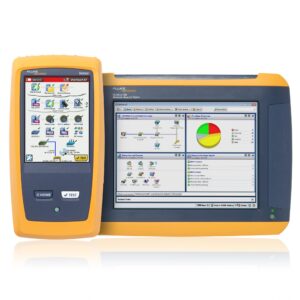Fluke Networks added new testing support for deploying 802.11ac networks in the enterprise, launching a tablet solution aimed at network engineers, and a handheld tester, the OneTouc AT Generation 2 Network Assistant, for technicians.
Between the two options, Fluke (now part of NetScout Systems) is staying true to its philosophy of the “right tool for the right person,” according to Dan Klimke, product marketing manager at Fluke Networks. The Optiview XG Network Analysis Tablet runs Fluke’s AirMagnet Mobile test suite.
In general, Klimke said, enterprises are no longer just dealing with on-premise equipment and connectivity to the wide area network.
“It’s really anywhere, any time with this concept of a very complicated delivery environment over which the enterprise doesn’t have a lot of control,” Klimke said.
In addition, companies are increasing their reliance on Wi-Fi for basic business connectivity and work rather than as only a complement to wired connectivity – and those who are upgrading to 802.11ac expect to see return on that investment in the form of faster speeds, noted Chris Hinsz, senior product manager at Fluke. Interference, power compatibility and sufficient power access (often more than 15 watts) as well as backhaul bottlenecks are all coming up in 802.11ac installations, Hinsz said, and Fluke’s new solutions are meant to help engineers and technicians more efficiently deal with those problems.
In other test news this week:
–Anite had its Propsim F32 Channel Emulator selected by Cetecom to outfit the company’s U.S.-based anechoic chamber test lab designed for multiple-input/multiple-output, over-the-air testing that meets new CTIA requirements.
-The European Telecommunications Standards Institute has been tackling the issue of test-related language and communicating results. At this week’s ETSI User Conference on Advanced Automated Testing, the topic of test description language was one of the primary topics.
“There is a methodology gap between the high-level expression of what needs to be tested, such as the test purposes described in prose or test purpose language and the complex coding of the executable tests in Testing and Test Control Notation Version 3, a language recognized worldwide also developed in ETSI,” the organization said. “Test description language fills that gap.”
ETSI went on to to add “this language represents the next generation of testing languages, exploiting the advantages of model-based software engineering. Test description language will offer higher quality tests through better design, seamless integration of methodology and tools, better and faster test development and will be easier to review by non-testing experts.”
ETSI added the use of TDL will be primarily functional testing and that the first standard is being worked on by the ETSI Methods for Testing and Specification committee, with a reference implementation to be made publicly available in the first half of next year.
–Keysight Technologies released the latest version of its BenchVue software that enables the creation of simple, custom automated tests, among other new features. Keysight also launched three new curve tracer packages for its B1506A Power Device Analyzer for the energy and automotive markets, and gained a new board member. Robert Rango, formerly the EVP and general manager of Broadcom’s mobile and wireless group, will be joining Keysight’s board as of Nov. 1.
–Spirent Communications has a new partnership to measure mobile customer experience with AdvaComm Associates in the Middle East, which provides network planning and optimization services to operators across a range of wireless technologies, from cellular to TETRA to Wi-Fi.
Spirent also announced this week that Renault will be using Spirent’s Automotive Ethernet BroadR-Reach test solution for conformance and performance testing for in-vehicle networking for the connected car; as well as a new nation-wide agreement for Spirent’s device analytics unit, Tweakker, with Flash Wireless. Flash will be using Tweakker’s automatic device configuration tool as well as adding Tweakker’s smartphone device guides to its self-care options for customers.

